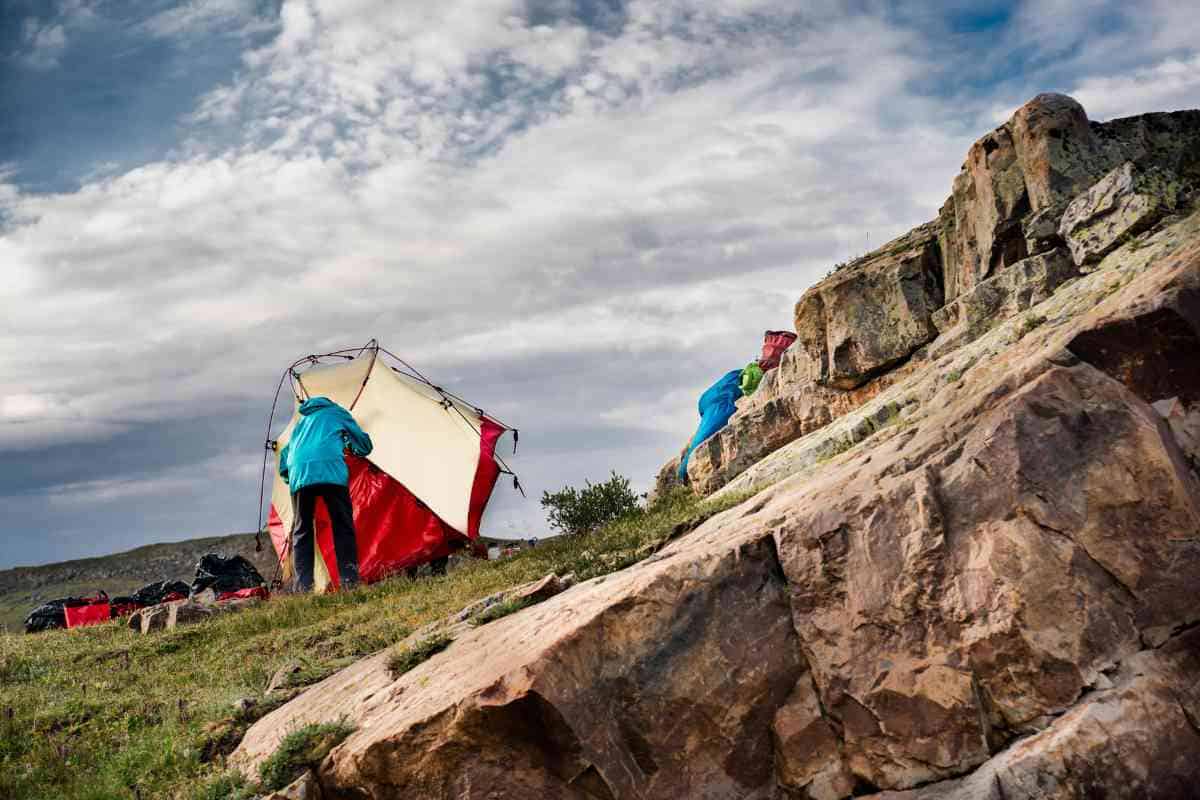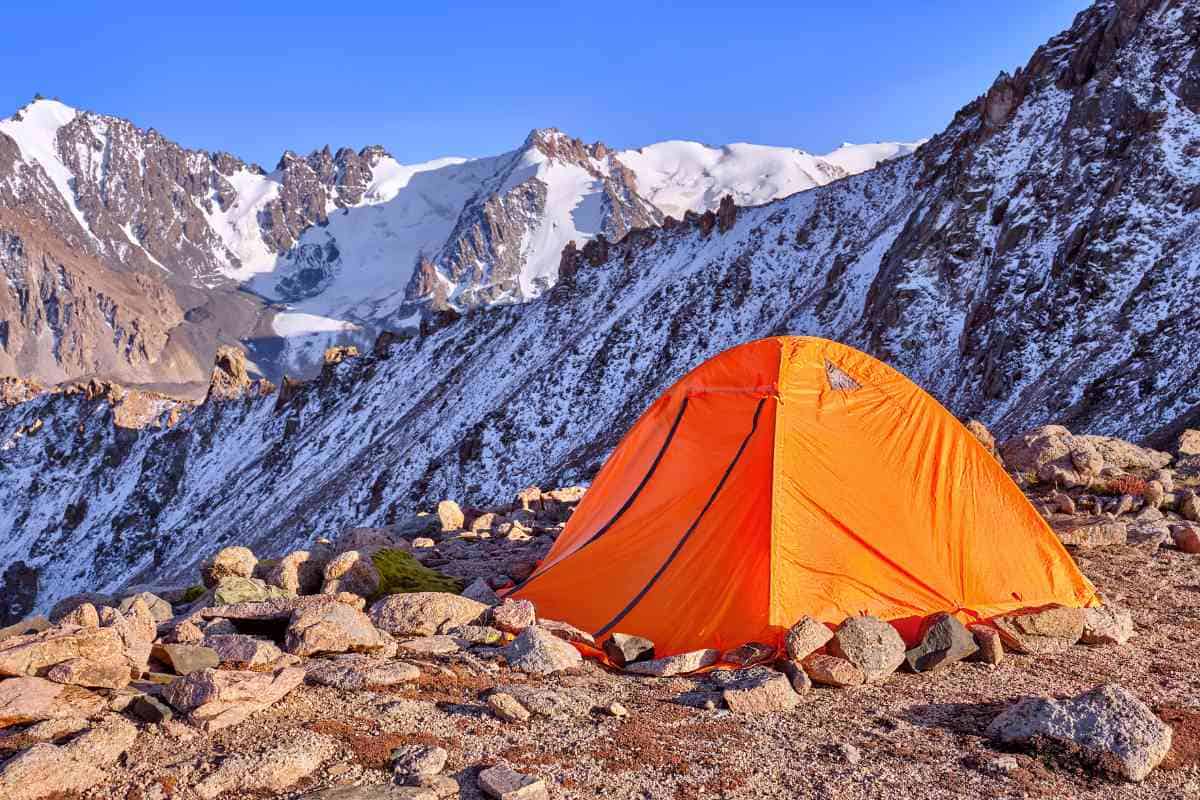How Much Wind Can A Tent Take?
For those who like to spend time in the great outdoors, one question that sometimes comes up is how much wind a tent can take and still stay upright.

How much wind can my tent withstand?
Most tents can withstand winds of up to 20 miles per hour, though they can withstand more if you use stakes to secure your tent, or if you place heavy items inside the tent to further secure it against nature’s harsher elements.
Tent camping has long been one of my favorite things to do. Not only that, but – unlike many people – I usually like it best when mother nature is giving me some challenges.
Sleeping outdoors during a big storm is an amazing experience, but you’ll want to make sure you have adequate protection for the experience to actually be enjoyable for you and any others who may be camping with you.
For this reason, it’s a good idea to make sure you know how much wind your tent will be able to withstand if and when you want to camp when the weather is less than ideal.
Keeping Your Tent Stable In The Wind
Like I said earlier, camping outdoors doesn’t have to end just because the weather isn’t perfect.
Instead, being in a well-protected shelter during a rainstorm or other weather changes when you’re out at a campground or in the woods can feel warm and cozy if the elements are right.
Many of today’s tents are better designed for harsher environmental elements. Some are made to withstand winter temperatures and keep you cozy even when the thermostat is dropping.
Today’s tents are also designed for hotter temperatures as well. Most come with a number of windows for better ventilation and cross-flow.
They are also made of materials that allow the inside to stay cooler than some of the materials of the past.
But a windstorm can definitely be different, especially if you aren’t prepared for it.
Wind can be anything from slightly inconvenient to destructive. Trying to keep things from blowing away is tough when you are at a campground site or on a trail, but it can become worrisome if the wind might actually cause real damage to your things – or worse – to you or others in your group.
So…it’s a good idea to know ahead of time how much wind your tent is going to be able to sustain, and what you can do to make it likely that your tent can withstand more.
1. Most Tents Can Withstand Winds of Up to 20 Miles per Hour

Tents today are designed to be able to handle many things that mother nature throws at them, and wind is (sometimes) one of them.
Wind gusts of anything below 10 miles per hour are considered “breezy” more than bothersome.
At this speed, you’ll have some blowing leaves and a nice bit of air flowing through your campground. But this speed of wind won’t cause any concern, and can even be pleasant, especially on a hot day.
Winds that start to pick up to between 10 and 20 miles per hour can start to be a bit more annoying and may make it a little less fun to be out camping.
At this speed, the winds will be a bit more annoying. Trying to keep things from fluttering around or knocking over can be just problematic enough to make your experience somewhat less fun. But, you more than likely will still not have any problems with your tent wanting to move around, and most things can be easily secured with a few heavier items to help hole down the lighter ones.
Once the winds get to above 20 miles per hour your camping experience may begin to be significantly altered. There will be much more swaying in the trees and it might be a challenge to keep a campfire lit, or a campfire may not be allowed at all by the place you are setting up for the evening.
At 20 miles per hour and above, the majority of tents aren’t designed to withstand these types of winds and you’re going to have to either consider taking down the tent, or coming up with alternative ways to secure things so that you can continue to camp.
That said, at 20 miles per hour winds and above, even if you can secure your tent from blowing away, the rest of your camping items are going to be moving and it just may mean that it’s no longer enjoyable to continue the camping trip.
But – if you are the kind of camper that doesn’t want a wind to end your trip, or if you’re in a position where you can’t end the trip, there are some things you can do to keep your tent secure, even as the winds around it begin to howl.
2. Use Stakes to Secure Your Tent
If you are out camping and the winds start to pick up, it’s a good idea to go ahead and stake your tent right away.
Wind is one of mother nature’s most unpredictable forces and it can change at almost any time, with very little notice.
I’ve been in situations where a light 8 to 10 mile per hour breeze suddenly became a wind that was a force to be reckoned with. And – believe me – chasing a 6 person tent through a campground is not a pleasant experience!
In fact, there’s no harm in staking your tent when you first put it up, even if there is little to no wind at the moment. Staking a tent usually takes little effort and is easily done with the stake poles and a small hammer, or anything heavy enough to act as one.
In some places, the ground will even be soft enough to handle the stakes by just pushing them into the dirt with your bare hand.
3. Place Heavy Items Inside the Tent
And finally, if you are stuck in a situation where the winds are beginning to pick up, yet you find yourself without any stakes to secure your tent, you can always start moving some of your heavier items into the tent to help secure it and keep it from moving or blowing away.
Items like coolers, folding chairs, or even your cookstove (as long as no propane is attached to it) are all good options for helping to weigh down the tent.
You can also grab rocks or large pieces of wood to help hold it in place.
And – if you are stuck in a windstorm that is strong enough to be moving your tent, there’s a good chance you and your fellow campers are going to be heading to the tent for some protection from the wind. Sometimes just the weight of your bodies might be enough to keep the tent in place, at least until the wind dies down.
Key Takeaways
- Tents continue to improve and can handle harsher weather elements than ever before.
- Though it can be fun to be able to camp even when weather doesn’t seem ideal, you’ll need to be prepared for certain elements, like high winds, that could be more than just annoying and turn destructive instead.
- Most tents can withstand winds of up to 20 miles per hour, though they can withstand more if you use stakes to secure your tent, or if you place heavy items inside the tent to further secure it against nature’s harsher elements.






